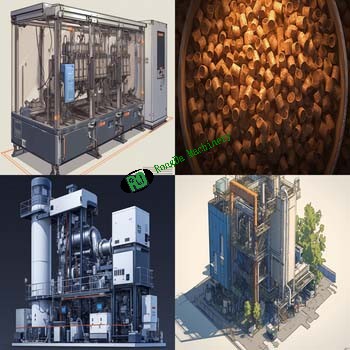Welcome to Rongda Machinery Co., Ltd
Toggle Navigation
Picture this: it’s a chilly winter evening, and you’re cozying up at home without worrying about sky-high heating bills or harming the planet. That’s where biomass pellet combustion systems come in—a smart, green way to heat your home or business using stuff like wood scraps and crop leftovers. These systems are catching on fast, and I’m here to break down why they’re worth your attention, without sounding like a science textbook.

At its core, a biomass pellet system is like a high-tech fireplace that runs itself. You’ve got these small, tightly packed pellets—think sawdust, crop stalks, or forestry bits squished into tiny cylinders. They’re stored in a hopper, and a clever little mechanism (called an auger) feeds them into a combustion chamber. A spark from an electronic ignition gets the fire going, and because the pellets are super dry (with less than 10% moisture), they burn cleanly and efficiently, leaving barely any mess behind. It’s like the system’s doing all the hard work while you sip hot cocoa.
First off, these systems are super efficient. We’re talking thermal efficiencies of 85% or higher—some fancy models even hit 90%. In plain English, that means you’re getting way more heat from less fuel compared to old-school coal boilers, which can waste up to 30% more fuel for the same warmth.
Then there’s the eco-friendly angle. When these pellets burn, they release CO₂, sure—but it’s roughly equal to what the plants soaked up while growing, so it’s considered carbon-neutral. Plus, they produce way less smoke and gunk than coal systems. Tests show particulate emissions are about 10% of what coal churns out, and there’s almost no sulfur oxide to worry about. It’s like giving the planet a high-five.
Oh, and your wallet will thank you, too. In places like northern China, using biomass pellets can slash heating costs by about 40% compared to natural gas. Plus, with programs like China’s Clean Heating Initiative offering subsidies, you could see a return on investment in just 3–5 years.
These systems aren’t just for tech geeks—they’re practical for all sorts of settings. Got a small house? There’s a compact unit for that. Running a big factory? Industrial-scale models have you covered. Some systems even come with smart controls, so you can tweak the temperature from your phone while you’re out grabbing coffee.
And here’s a cool bonus: the ash left behind isn’t just trash. It’s packed with nutrients like potassium and phosphorus, so you can process it into fertilizer for your garden or local farm. It’s like getting a two-for-one deal: heat your space and feed your plants.
Scandinavia’s all over this—over 60% of standalone homes there use pellet heating. In China, places like Shandong and Heilongjiang are building entire heating networks for farms and industrial parks. Plus, with carbon credit systems popping up, businesses can actually make money by cutting emissions, which makes these systems even more appealing.
Biomass pellet combustion systems aren’t just another gadget—they’re a practical way to stay warm, save money, and cut down on pollution. Whether you’re heating a cozy cabin or a sprawling warehouse, they offer a cleaner, cheaper path to keeping things toasty. With more people jumping on board and governments backing green energy, this tech is reshaping how we think about heating. So, next time you’re shivering, maybe it’s time to consider going green with biomass pellets.